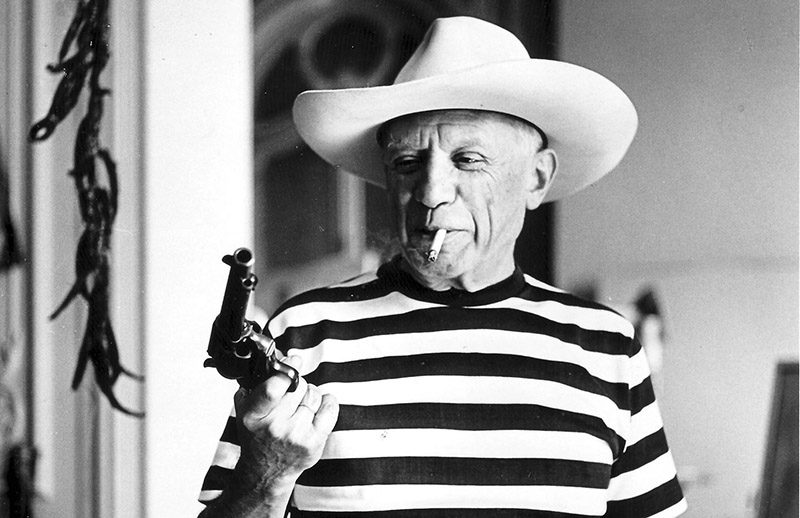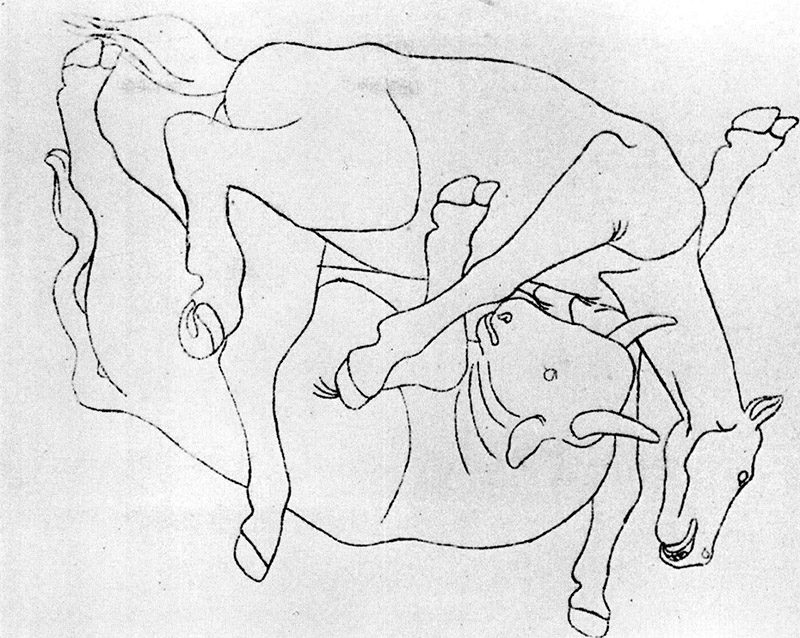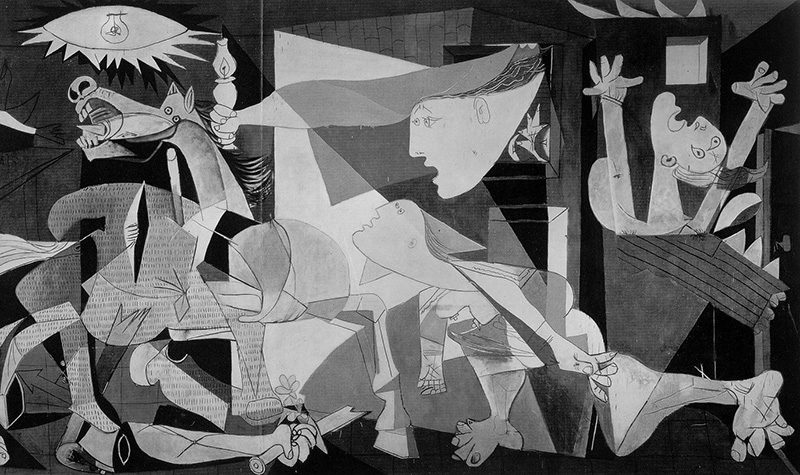TRACES: Pablo Picasso
 Today is the occasion to bear in mind Pablo Picasso (25/10/1881-8/4/1973), he is probably the most important figure of 20th century, in terms of art and art movements that occurred over this period. Before the age of 50, the Spanish Artist, had become the most well-known name in modern art, with the most distinct style and eye for artistic creation, his many relationships with women not only filtered into his works but also may have directed its course. This column is a tribute to artists, living or dead, who have left their mark in Contemporary Art. Through documents or interviews, starting with: moments and memories, we reveal out from the past-unknown sides of big personalities, who left their indelible traces in time and history…
Today is the occasion to bear in mind Pablo Picasso (25/10/1881-8/4/1973), he is probably the most important figure of 20th century, in terms of art and art movements that occurred over this period. Before the age of 50, the Spanish Artist, had become the most well-known name in modern art, with the most distinct style and eye for artistic creation, his many relationships with women not only filtered into his works but also may have directed its course. This column is a tribute to artists, living or dead, who have left their mark in Contemporary Art. Through documents or interviews, starting with: moments and memories, we reveal out from the past-unknown sides of big personalities, who left their indelible traces in time and history…
By Efi Michalarou
Pablo Picasso was born in Málaga, his relations with his various mistresses and wives were sometimes overlapping, sometimes, private or public, were very important for him, because every time he changed his companion, he changed his painting style. For his relationships he had said “Every time I change a woman, I have to burn the one that was the last. So I get rid of them. They will no longer be around me and to complicate my life. It may also return my youth. Killing women, destroying the past, which she represents…“. He was the son of the Academic Painter, José Ruiz Blasco, Picasso began to draw at an early age. In 1895 the family moved to Barcelona, and studied at La Lonja, the Academy of Fine Arts. In 1900 he made his first trip to Paris, there he met the journalist and poet Max Jacob, who helped Picasso learn the language and its literature. These were times of severe poverty, cold, and desperation. During the 5 months of 1901, Picasso lived in Madrid, where he and his anarchist friend Francisco de Asís Soler founded the magazine Arte Joven, which published 5 issues. Soler solicited articles and Picasso illustrated the journal, mostly contributing grim cartoons depicting and sympathizing with the state of the poor. Picasso’s Blue Period is characterized by somber paintings rendered in shades of blue and blue-green, only occasionally warmed by other colors, began either in Spain in early 1901, or in Paris in the second half of the year. His Rose Period is characterized by a more cheery style with orange and pink colors, and featuring many circus people, acrobats and harlequins. The harlequin, a comedic character usually depicted in checkered patterned clothing, became a personal symbol for Picasso. He met Fernande Olivier, his first great love in his life, whom he met in 1904, incorrigibly lazy and promiscuous, but with a lively and independent mind, she was a popular artist’s model, a kind of “it” girl of the Parisian avant-garde. Physically obsessed with her languid, bemused presence, Picasso moved from the poetic romanticism of his Rose Period to a new way of working inspired both by the dynamism of modern Paris and by the enduring values of Mediterranean culture. In 1906, Olivier accompanied him to the village of Gosol in the Spanish Pyrenees, where the cubistic traditional architecture and her strong, sensual features were endlessly analysed in a vast body of drawings that led to the most influential painting of the 20th century “Demoiselles d’Avignon”. When Olivier took up with a minor Italian artist in 1912 in an attempt to pique his jealousy, Picasso began seeing Eva Gouel. While Picasso later claimed he knew greater contentment with her than anyone else, he carried on an affair as Eva lay dying in 1915. Picasso’s African-influenced Period begins with “Les Demoiselles d’ Avignon”, which were inspired by African artifacts. Analytic cubism is a style of painting Picasso developed with Georges Braque using monochrome brownish and neutral colors. Both artists took apart objects and “analyzed” them in terms of their shapes. Picasso and Braque’s paintings at this time share many similarities. Picasso’s marriage with the Russian dancer Olga Khokhlova in 1915, coincided with a complete reversal in his artistic direction. Yet just as Picasso’s artistic restlessness couldn’t be contained for more than a few hours, so the desire of the socially ambitious Khokhlova to tame the now wealthy artist soon began to suffocate him. As their relationship disintegrated and she became increasingly delusional, his depictions of her and women in general grew ever more hateful – tortured masses of teeth, limbs and vaginas. While Picasso’s sense that he could do what he liked with absolutely anyone increased as his fame and wealth grew. The two remained legally married until Khokhlova’s death in 1955 and had a son, Paulo. In February 1917, Picasso made his first trip to Italy. In the period following the upheaval of World War I, Picasso produced works in a neoclassical style. This return is evident in the work of many European artists in the 1920s, including André Derain, Giorgio de Chirico, Gino Severini, Jean Metzinger, the artists of the New Objectivity movement and of the Novecento Italiano movement. Picasso’s paintings and drawings from this period frequently recall the work of Raphael and Ingres. In 1925 the Surrealist writer and poet André Breton declared Picasso as “one of ours”’ in his article “Le Surréalisme et la peinture”, published in Révolution surréaliste. Les Demoiselles was reproduced for the first time in Europe in the same issue. Yet Picasso exhibited Cubist works at the first Surrealist group exhibition in 1925. Picasso met the 17 year-old Marie-Thérèse Walter, outside the Galeries Lafayette department store in Paris in 1927, but kept their affair secret for 8 years. She gave him a daughter, Maya Widmaier-Picasso, at about the time she was supplanted in Picasso’s affections by Dora Maar. She hanged herself in 1977. During the ‘30s, the minotaur replaced the harlequin as a common motif in his work. His use of the minotaur came partly from his contact with the surrealists, who often used it as their symbol, and it appears in Picasso’s Guernica. His next great muse was the one who came closest to challenging him on his own terms, an artist and photographer closely involved with the Surrealists. He first encountered Dora Maar across the tables of the Café aux Deux Magots, stabbing a knife between her fingers till she drew blood. Picasso asked to keep her bloodstained gloves. Maar was Picasso’s partner during the period of his greatest political engagement, she made a photographic record of Picasso’s work on the masterpiece “Guernica” and her unmistakable features appear in the banshee-like head swooping into the painting. But in Picasso’s most telling images of Maar, her features are disturbingly reconfigured, growing out of each other in all the wrong places, as though she is literally breaking down in front of us. When Picasso threw her over for the much younger Françoise Gilot in 1943, Maar suffered a complete mental collapse, followed by nun-like seclusion, Picasso and Paul Éluard sent Dora to their friend, the psychiatrist Jacques Lacan, for psychoanalytic treatment. “After Picasso, only God” she famously declared. She ended her days surrounded by dust-encrusted relics of her time with Picasso. Retreating to his studio, he continued to paint, producing works. Although the Germans outlawed bronze casting in Paris, Picasso continued regardless, using bronze smuggled to him by the French Resistance. In 1944, after the liberation of Paris, Picasso, then 63 years old, began relationship with a young art student named Françoise Gilot, she was 40 years younger than he was. As they embarked on their 9 year affair, the artist warned her “For me there are only two kinds of women, goddesses and doormats”. Eventually they had two children: Claude and Paloma. Let it should be thought that Picasso had things entirely his own way, the case of Gilot is instructive. This young aspiring artist seems to have handled Picasso’s cruelties and perversities with amazing deftness, and was the only woman to leave him entirely voluntarily, with her dignity more or less intact. While he captured Gilot’s features in a series of radiant drawings and etchings, this was the period of his greatest fame, when his millionaire life on the Cote d’Azur was cut off from external reality, and it was all too easy for the artist to “play Picasso” in art and life. In the 1950s, Picasso’s style changed once again, as he took to producing reinterpretations of the art of the great masters. He made a series of works based on Velázquez’s painting of “Las Meninas”. He also based paintings on works by Goya, Poussin, Manet, Courbet and Delacroix. The last of Picasso’s great loves was Jacqueline Roque, a sales assistant in the Madoura Pottery Studio, where Picasso created his ceramics, Jacqueline met Picasso in 1954, when she was 27 and became his second wife in 1961, he created more than 400 portraits of her. While she quarreled with his children over the division of his estate, they collaborated in the creation of the Musée Picasso. She shot herself in 1986. One of the statements he made and described him is: “It took me four years to paint like Raphael, but a lifetime to paint like a child”.














